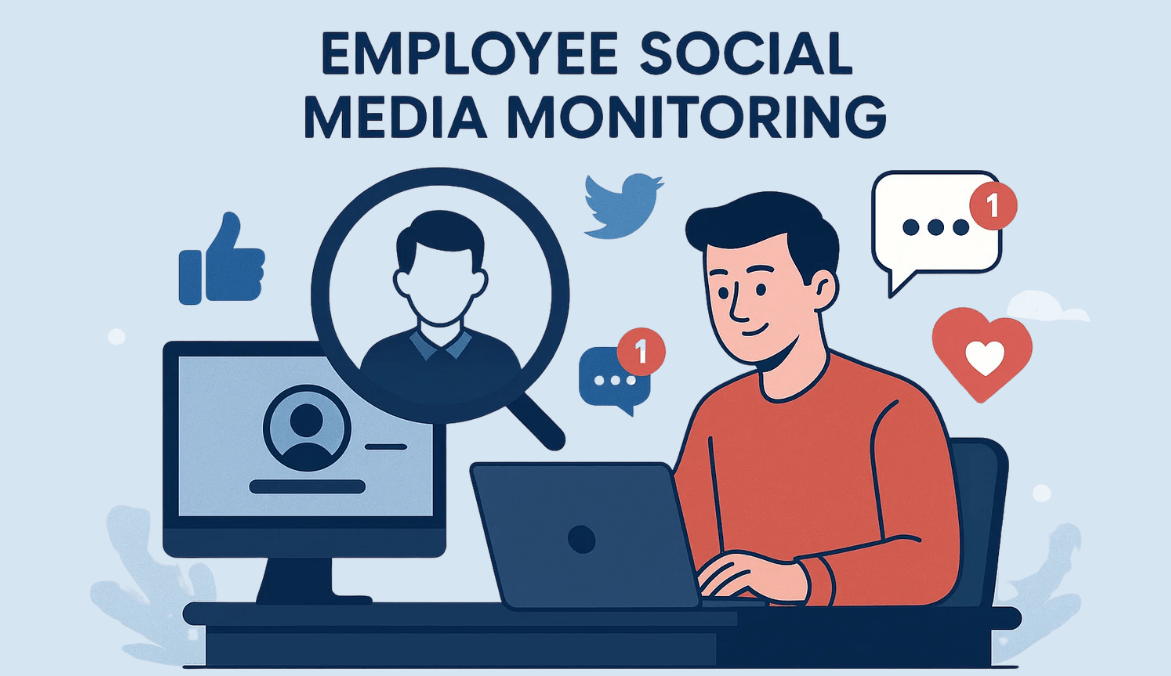Introduction
Social media is everywhere — in our pockets, on our desktops, and yes, in the workplace. It’s a double-edged sword: it can help employees stay informed and even amplify your company’s brand, but it can also distract staff, drain focus, and create legal or reputational risks if misused.
That’s why more organizations are turning to employee social media monitoring. Done well, it helps leaders improve productivity and protect compliance without creating a culture of mistrust. Done poorly, it can backfire, damaging employee engagement and even leading to lawsuits.
Drawing on over 12 years of experience advising HR and IT leaders, I’ve seen both outcomes. This guide will help you take the smarter path.
Why Social Media Monitoring Matters
Social media has become deeply embedded in daily life, and the workplace is no exception. Employees use it to connect, share, and even promote their company. But without guidelines or monitoring, it can quickly become a source of distraction and risk.
Productivity & Focus
- Research shows 89% of employees admit to wasting time on social media during work hours. Even single interruption breaks deep focus, and it takes about 23 minutes to regain focus.
- These interruptions add up — one distracted employee can lose several hours weekly, affecting team output and deadlines.
- Monitoring helps organizations understand usage patterns and encourage healthier digital habits, leading to better focus and efficiency.
Compliance & Risk
- Social media misuse can expose companies to data leaks, reputational harm, and even legal liability if harassment or confidential information surfaces online.
- For regulated industries like healthcare or finance, compliance breaches via social channels can result in heavy penalties.
- Monitoring provides a safety net, allowing organizations to spot issues early, apply corrective actions, and maintain compliance with laws like GDPR or NLRA.
Brand & Culture
- Employees are often seen as extensions of the company brand. A single negative or careless post can damage credibility.
- At the same time, social media can also be a positive force if aligned with company values — employees can act as authentic brand ambassadors.
- Monitoring ensures the balance: preventing harmful posts while enabling constructive engagement.
The Productivity Risks of Unchecked Social Media Use
Unchecked social media use impacts employees more than they realize:
- Notifications = broken focus → It takes 23 minutes to refocus after each interruption.
- Micro-distractions accumulate → Five minutes here and there quickly turn into lost hours across teams.
- Missed collaboration opportunities → When some employees are distracted, others carry extra load.
From my consulting experience: I once worked with a project team where three members regularly lost 30–40 minutes a day on social media. Across a quarter, this was the equivalent of nearly two full work weeks lost per person — enough to derail deliverables.
Legal & Ethical Risks Employers Can’t Ignore
- US Federal: Monitoring public posts is generally legal, but accessing private messages or accounts without consent is not. The NLRA also protects certain concerted activities (e.g., employees discussing workplace issues).
- US States: Several states prohibit employers from requesting social media passwords; some require clear notice before monitoring.
- EU/UK: GDPR requires employers to prove lawful basis, transparency, and necessity. A Data Protection Impact Assessment (DPIA) is often mandatory.
Example: A tech firm I advised quietly monitored closed employee Facebook groups. Within weeks, they faced legal complaints for overreach. The intent was productivity, but the execution crossed a line.
What Is Employee Social Media Monitoring?
Employee social media monitoring is the practice of reviewing social media activity that could affect workplace performance or organizational risk. This includes:
- Workplace usage: Social media activity during work hours on company devices or networks.
- Public mentions: Posts that mention your brand, clients, or workplace.
- Escalations: Cases of harassment, leaks, or reputational threats reported internally.
It does not mean spying on private accounts or punishing off-duty, lawful behavior. The difference between reasonable monitoring and over-surveillance is what defines success.
Benefits of Monitoring the Right Way
When implemented thoughtfully, employee social media monitoring creates value for both organizations and employees.
Boost Productivity
Monitoring highlights how much time is lost to personal scrolling and helps teams build healthier digital habits. The result: fewer distractions, improved focus, and stronger output.
Protect Compliance & Security
Social media misuse can lead to data leaks, regulatory breaches, or workplace harassment issues. Monitoring ensures risks are identified early and addressed before they escalate.
Fair Accountability
With consistent monitoring, everyone is held to the same standard. This removes bias, ensures fairness, and gives managers reliable data instead of relying on assumptions.
Support Employee Engagement
Transparency around monitoring can build trust. When employees know what’s tracked (and why), it creates clarity, reduces suspicion, and fosters a sense of shared responsibility.
Safeguard Brand Reputation
Employees are the face of your organization online. Monitoring helps prevent reputational harm from negative or careless posts, while also encouraging positive brand advocacy.
Best Practices to Monitor Without Micromanaging
The difference between smart monitoring and micromanagement comes down to how you implement it. The goal is to protect productivity and compliance without making employees feel like they’re under constant surveillance.
Be Transparent From the Start
Clearly explain why monitoring is in place, what’s being tracked, and what isn’t. When employees understand that the goal is productivity and fairness — not spying — they’re more likely to accept it.
Define Clear Boundaries
Limit monitoring to work hours, company devices, and public content. Off-duty or personal use should remain private. Drawing these lines helps build trust.
Focus on Patterns, Not Play-by-Play
Instead of checking every click, analyze broader trends: how much time teams spend on productive apps versus distractions. Managers should look for patterns that point to productivity gaps rather than nitpicking individuals.
Use Monitoring as a Coaching Tool
Share insights with employees to encourage self-improvement. For example, if a team spends 20% of work time on non-work platforms, turn it into a coaching conversation, not a punishment.
Set Fair, Realistic Expectations
Let employees know what “healthy social media use” looks like. A few minutes here and there may be fine — the issue is when usage disrupts focus or collaboration.
Review and Adjust Regularly
Monitoring isn’t “set and forget.” Review reports, listen to employee feedback, and refine your approach. This keeps the system fair and relevant as work patterns evolve.
One practice I’ve seen work well is sharing aggregate reports with teams rather than only managers. It turns monitoring into a shared responsibility, where employees can self-correct before it becomes an HR issue.
Tools & Techniques That Work
Not all monitoring tools are created equal. The best ones balance productivity insights with privacy safeguards. Here’s what to look for:
Time & Activity Monitoring
Track how much time employees spend on productive apps versus social media or non-work platforms. This helps identify patterns without micromanaging every click.
Screen Usage & Website Reporting
Instead of constant live feeds, use tools that provide summaries of app and website usage. High-level reports are enough to spot distractions and keep teams accountable.
Privacy-First Configurations
Choose tools that support role-based access, data minimization, and clear retention limits. That way, sensitive information is protected while still giving managers visibility.
Dashboards & Productivity Trends
Look for solutions that provide visual dashboards. Aggregate data on focus time, app usage, and productivity scores make it easier for managers and employees to have constructive conversations.
Integrations With Collaboration Tools
Tools that sync with project management platforms (like Karya Keeper, Asana, or Trello) offer richer insights by showing not just time spent, but progress against tasks.
The key is to use monitoring tools as decision-support systems, not surveillance systems. They should give leaders clarity on productivity patterns and risks — without creating a culture of fear.
Balancing Productivity with Trust
The hardest part of social media monitoring isn’t the technology — it’s maintaining trust. Employees want to feel respected, not watched. Striking this balance is what separates successful programs from ones that backfire.
Communicate the “Why” Clearly
Be upfront: monitoring is about protecting productivity, compliance, and fairness, not spying. When the purpose is clear, employees are more likely to accept it.
Respect Boundaries
Keep monitoring limited to work hours, company devices, and public data. Avoid crossing into off-duty or personal-device use. Boundaries show employees you respect their privacy.
Involve Employees in the Process
Share draft policies, gather feedback, and explain how data will be used. Involving employees creates buy-in and reduces resistance.
Focus on Growth, Not Punishment
Use insights to coach teams on healthier digital habits rather than disciplining them for every slip. These positions monitoring as a supportive tool, not a control mechanism.
Think of monitoring less as surveillance and more as digital guardrails — helping employees stay focused while giving them confidence their privacy is respected.
Looking for a Smarter Way to Monitor Social Media and Productivity?
If you want to reduce distractions, protect compliance, and keep your workforce focused, Mera Monitor can help.
With automated time and activity tracking, insightful productivity reports, and role-based access controls, Mera Monitor gives you the visibility you need — without micromanaging your employees.
Sign up for Mera Monitor today and see how smarter monitoring can boost productivity and trust in your workplace.
Conclusion: Monitor Smart, Protect Productivity & Trust
Social media isn’t going away — but how organizations manage it will define whether it becomes a distraction or a strength. By combining productivity-focused monitoring with compliance-first safeguards, you can keep teams engaged, protect your brand, and build a culture of trust.
Monitoring done right isn’t about control — it’s about helping employees work smarter, safer, and more effectively in today’s digital workplace.
FAQs
Not always. When used for branding, networking, or customer engagement, social media can add value. The issue is when personal use dominates work hours, leading to frequent distractions and lost focus.
Yes, if it’s done transparently and within the law. Public posts and activity on company devices are generally allowed. But rules vary by country and state, so always communicate policies clearly and respect privacy boundaries.
Usually no. Employers shouldn’t monitor employee-owned devices unless it’s during work hours on company networks and with clear consent. A safer option is to monitor only company-managed devices.
Focus on patterns and outcomes, not every click. Use monitoring to highlight trends or productivity gaps, then share insights with teams to encourage improvement rather than punish individuals.
 Gift Card ₹999
Gift Card ₹999

